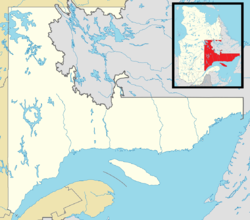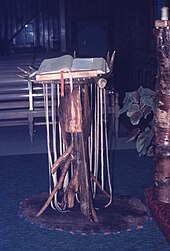
The Cree are a North American Indigenous people. They live primarily in Canada, where they form one of the country's largest First Nations.

The Innu / Ilnu or Innut / Innuat / Ilnuatsh ("people"), formerly called Montagnais from the French colonial period, are the Indigenous inhabitants of territory in the northeastern portion of the present-day province of Labrador and some portions of Quebec. They refer to their traditional homeland as Nitassinan or Innu-assi.
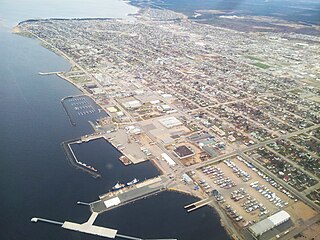
Sept-Îles is a city in the Côte-Nord region of eastern Quebec. It is among the northernmost locales with a paved connection to the rest of Quebec's road network. The population was 25,686 as of the 2011 Canadian census. The town is called Uashat, meaning "bay" in Innu-aimun.
Indigenous peoples in Quebec total eleven distinct ethnic groups. The one Inuit community and ten First Nations communities number 141,915 people and account for approximately two per cent of the population of Quebec, Canada.

Côte-Nord is a region that covers a territory of 351,523 square kilometres, which corresponds to 21% of the surface area of Quebec, Canada.
Maliotenam is a First Nations reserve in Quebec, located adjacent to the city of Sept-Îles. Together with Uashat some distance away, it forms the Innu community of Uashat-Maliotenam. The community is a part of the Manicouagan district which is represented by Bloc Québécois MP Marilène Gill. The community has a population of approximately 1,600 people.
Innu-aimun or Montagnais is an Algonquian language spoken by over 10,000 Innu in Labrador and Quebec in Eastern Canada. It is a member of the Cree–Montagnais–Naskapi dialect continuum and is spoken in various dialects depending on the community.

Nutashkuan (INAC) or Natashquan (CGNDB) is a First Nations reserve in the Canadian province of Quebec, belonging to the Première Nation des Innus de Nutashkuan band. The reserve is located on the north shore of the Gulf of St. Lawrence at the mouth of the Natashquan River, 336 km (209 mi) east of Sept-Îles and has been accessible by Route 138 since 1996.
La Romaine, also known as Unamenshipit in Innu-aimun, is an Innu First Nations reserve in the Côte-Nord region of Quebec, Canada, at the mouth of the Olomane River on the Gulf of Saint Lawrence. It belongs to the Innu band of Unamen Shipu. Being an enclave within the Municipality of Côte-Nord-du-Golfe-du-Saint-Laurent, it is geographically within Le Golfe-du-Saint-Laurent Regional County Municipality but administratively not part of it. Directly adjacent to the reserve is the community of La Romaine consisting of a small French-speaking population.

Pessamit, is a First Nations reserve and Innu community in the Canadian province of Quebec, located about 50 kilometres (31 mi) southwest from Baie-Comeau along the north shore of the Saint Lawrence River at the mouth of the Betsiamites River. It is across the river directly north of Rimouski, Quebec. It belongs to the Pessamit Innu Band.
Pakuashipi is an Innu community in the Canadian province of Quebec, located on the north shore of the Gulf of Saint Lawrence in the Côte-Nord region. It is on the western shore of the mouth of the Saint-Augustin River, opposite the settlement of Saint-Augustin. It is not an Indian reserve, but an Indian settlement within the Municipality of Saint-Augustin, occupied by the Innu band of Pakua Shipi. Although they hold no formal legal title to the land at this time, negotiations are still ongoing to determine their indigenous rights.
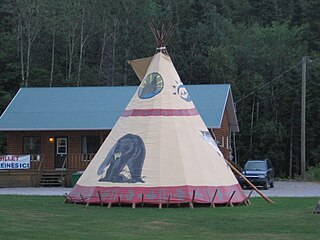
Essipit is an Innu Indian reserve in the Canadian province of Quebec, located on the north shore of the Gulf of Saint Lawrence in the Côte-Nord region. It belongs to the Innue Essipit First Nation.

Mashteuiatsh is a First Nations reserve in the Saguenay–Lac-Saint-Jean region of Quebec, Canada, about 6 kilometres (3.7 mi) north from the centre of Roberval. It is the home to the Pekuakamiulnuatsh First Nation. It is located on a headland jutting out on the western shores of Lake Saint-Jean known as Pointe-Bleue, in the geographic township of Ouiatchouan, and belongs to the Montagnais du Lac St-Jean Innu band. It is geographically within the Le Domaine-du-Roy Regional County Municipality but administratively not part of it.

The Atikamekw are an Indigenous people in Canada. Their historic territory, Nitaskinan, is in the upper Saint-Maurice River valley of Quebec. One of the main communities is Manawan, about 160 kilometres (99 mi) northeast of Montreal.

Innus of Ekuanitshit are a First Nation band in Quebec, Canada. They live primarily in the Indian reserve of Mingan on the north coast of the St Lawrence River. As of October 2019, the band had a registered population of 677 members.
Première Nation des Innus de Nutashkuan is an Innu First Nations band government in Quebec, Canada. The band lives on Nutashkuan, an Indian reserve in the Côte-Nord region. As of 2021, they have a registered population of 1,217 members. They are part of the Regroupement Mamit Innuat tribal council.

The Pessamit Innu Band, which the official name is bande des Innus de Pessamit, is an Indian band of the Innu First Nations in Quebec, Canada. Its members primarily live on the Indian reserve of Pessamit in the Côte-Nord, the north shore of Saint Lawrence River, which is also the seat of the band. In 2017 it has a registered population of 3,953 members. It is governened by a band council called Conseil des Innus de Pessamit and it is affiliated with the Mamuitun Tribal Council. The band was previously known as Bersimis and Betsiamites.
Marcelline Picard-Kanapé, a.k.a.Marcelline P. Kanapé, is considered one of the great specialists in education among First Nations in Canada, distinguishing herself since the 1950s. She was the first Innu teacher in Quebec, the first Aboriginal person to serve on the Conseil supérieur de l'éducation, and the first female Innu chief.
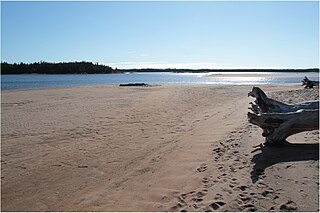
Mingan River is a 117-kilometre (73 mi) salmon river of the Côte-Nord region of Quebec. It flows from north to south and empties into the Gulf of Saint Lawrence.
Rita Mestokosho, born 1966 in Ekuanitshit (Mingan), is an indigenous writer and poet, councillor for culture and education in the Innu nation.
